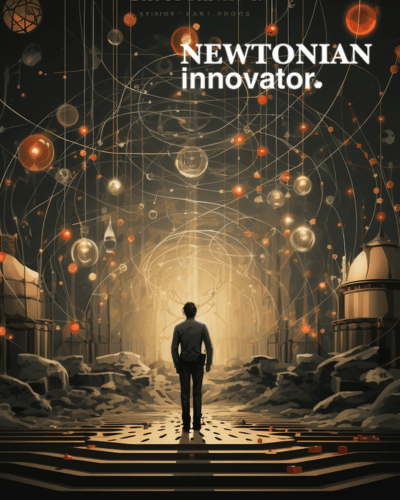In the vastness of scientific discovery, certain figures have stood out in history for their ability to challenge and reshape our understanding of the universe. Niels Bohr did just that with his deep philosophical inclinations and contributions to quantum mechanics–undoubtedly one of these luminaries. His exploration into the very nature of light and matter has not only expanded the boundaries of physics, but has also showcased the profound interplay between observation and reality.
Niels Bohr, a Danish physicist born in 1885, was a central figure in the early development of quantum mechanics. Bohr studied at the University of Copenhagen, where he later established the Institute for Theoretical Physics. At the heart of Copenhagen, this Institution became more than just a place of learning, it was a melting pot of ideas. Scientists from various backgrounds and nationalities congregated, bringing with them diverse perspectives. This environment of collaboration and open dialogue was instrumental in the evolution of quantum mechanics.
In his personal life, Bohr was deeply interested in philosophy and often sought to bridge the gap between scientific inquiry and philosophical understanding. He was known for his patience, humility, and ability to listen intently to others’ viewpoints. This made him a beloved figure among his peers and students. Bohr believed in the power of collective thinking, often stating that the best ideas emerged from spirited discussions and debates. His contributions to the field were profound, and his philosophical insights into the nature of quantum phenomena have shaped the way we understand the subatomic world. In 1922, Bohr was awarded the Nobel Prize in Physics for his work on the structure of atoms and the radiation emanating from them.

One of Bohr’s most significant contributions to quantum mechanics is the principle of complementarity. This principle asserts that objects have multiple properties that cannot be observed or measured simultaneously. For instance, one can observe either the particle-like or wave-like behavior, but never both simultaneously.
Imagine shining light through two closely spaced slits onto a screen. If light behaved purely as particles, one would expect to see two bright lines on the screen corresponding to the slits. However, what is observed is an interference pattern, suggesting that light behaves as waves.
Now, if we reduce the intensity of light such that only one photon passes through the slits at a time, the interference pattern still builds up over time. This is puzzling because it suggests that each photon interferes with itself, behaving as both a particle and a wave.
Bohr argued that the photon doesn’t have an inherent “wave” or “particle” nature independent of the measurement. Instead, the experimental setup determines which aspect of the photon’s nature is revealed. This is the essence of complementarity, the full description of quantum phenomena requires both wave and particle perspectives.
Bohr’s principle of complementarity wasn’t just a scientific proposition, it was deeply philosophical. It touched upon age-old questions about the nature of reality and our role as observers. Can we ever claim to know the true nature of an object, or are we forever limited by our means of observation? Bohr’s insights suggest that reality is not just out there waiting to be discovered, but is dependent on the ways we choose to observe it.
Bohr’s complementarity principle was not universally accepted. Albert Einstein, for instance, was a vocal critic. He believed in a deterministic universe and felt that quantum mechanics as interpreted by Bohr was incomplete.
Their debates, especially the one surrounding the Einstein-Podolsky-Rosen (EPR) paradox, are legendary in the hall of physics history. While Einstein proposed the EPR thought experiment to challenge the completeness of quantum mechanics, Bohr defended the theory, emphasizing that the results of measurements are always context-dependent.
While Einstein and Bohr engaged in numerous debates over the nature of quantum mechanics, Einstein never fully accepted Bohr’s interpretation. Einstein’s famous statement, “God does not play dice with the universe,” encapsulates his discomfort with the inherent probabilistic nature of quantum mechanics as Bohr described it. However, subsequent experiments have consistently supported the quantum mechanics predictions and Bohr’s interpretation, eventually resulting in the majority of the physics community to side with Bohr’s viewpoint.
Bohr’s complementarity principle challenges our classical intuitions about the nature of reality. It suggests that the properties of quantum systems are not inherent, but are co-created by the act of measurement. This perspective has profound philosophical implications. It blurs the line between subject and object, suggesting that the observer plays an active role in shaping the observed reality. This idea resonates with certain Eastern philosophical traditions, which Bohr was known to have studied.

Bohr’s studies into the nature of quantum phenomena have left an indelible mark on the field of physics. His willingness to embrace the counterintuitive and his ability to articulate the philosophical implications of scientific discoveries made a scientific legend.
To further highlight the implications of his discovery, Imagine you are given a quantum coin that, when flipped, lands in a superposition of heads and tails. You can’t see the result until you measure it. Once you do, the superposition collapses to either heads or tails. But until you look, the coin exists in both states simultaneously.
Would you bet on the outcome? How does the act of observing change the outcome? Jump into the world of quantum mechanics and explore the boundary between the observer and the observed, where reality is far stranger than fiction.
Beyond his contributions to quantum mechanics, Bohr’s legacy lies in his approach to science. He demonstrated that scientific inquiry is not just about collecting data and formulating theories. It’s also about asking deep philosophical questions and seeking answers that resonate both scientifically and philosophically. Today’s physicists, philosophers, and even students are inspired by Bohr’s holistic approach, recognizing that true understanding comes from bridging the gap between the empirical and the conceptual.
Niels Bohr’s journey through the realms of quantum mechanics serves as hope for today’s researchers and innovators. His approach, deeply rooted in both scientific rigor and philosophical inquiry, highlights the importance of not just accepting the observable but questioning the very nature of observation. For modern-day thinkers, adopting a Bohrian mindset means embracing the unknown, challenging established norms, and being open to perspectives that might seem counterintuitive. It’s about recognizing that the boundaries of knowledge are not fixed. but are ever-expanding horizons waiting to be explored.
It’s crucial to approach challenges with a blend of curiosity, skepticism, and wonder, much like Bohr did. Innovators should cultivate an interdisciplinary mindset and always be ready to question the status quo. By intertwining science with philosophy, one can achieve a deeper understanding, leading to innovations that are not just scientifically advanced, but also philosophically profound. In the spirit of Niels Bohr, let’s venture into the unknown, to dream big, to question everything, and look beyond the boundaries of what’s possible.






